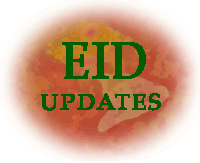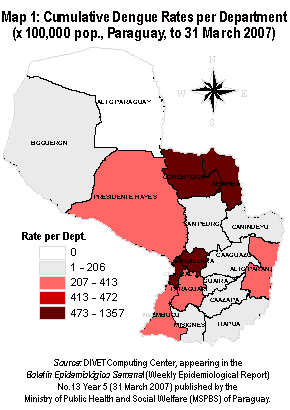
EID Updates:
Emerging and Reemerging Infectious Diseases,
Region of the Americas
Vol. 4, No. 8 (16 April 2007) Main Updates index
Dengue Outbreak Continues to Subside in Paraguay

Summary of the Current Situation in Paraguay
The Paraguayan government has continued the epidemiological alert throughout the national territory, in light of recent cases of dengue and dengue hemorrhagic (DH)
Up to 9 April 2007 (Epidemiological Week/ EW No. 15), as a follow-up to the March 15 update, the Ministry of Health of Paraguay reports the following:
- 25,021 reported cases of dengue
- 52 cases of DH
- 13 deaths: 5 from atypical dengue, 6 from DH, and 2 from unconfirmed dengue
- Case-fatality rate: 11.5%
- Affected departments:
Capital, Cordillera, Amambay, Central, Concepción, and Paraguarí
Adverse Event: Dengue in Paraguay
Date of Occurrence: In October 2006, an increase of dengue cases appeared with the DEN-3 serotype.
Specific Area of Impact: Cases have been reported in 17 of the 18 departments in the country.

1. Brief Description of the Adverse Event
From 1 January to 9 April 2007, 25,021 cases have been reported nationally. To date, 52 cases of DH have been reported. There have been 13 deaths: six from DH, five from atypical forms, and two from unknown causes. The case-fatality rate for DH to date is 11.5%. Of all reported cases of DH, 55% have occurred among males. The most affected age group are persons age 15 to 29 years (37% of the total), followed by those age 1 to 14 years (35%).
The behavior of this epidemic has varied throughout the country. The departments exceeding the average reporting rate for the country are, in order of frequency, Capital, Cordillera, Amambay, Central, and Concepción, followed by Paraguarí.Capital shows an incidence rate of 1,357.2 cases for every 100,000 inhabitants.
Reports indicate that the peak of the epidemic occurred between EWs 8 and 9; although Amambay and Concepción Departments showed an increase in the incidence rate of reported cases during EWs 11 and 12. Toward EW 12, it became clear that rates were falling in all departments—with the exception of Amambay, Cordillera, and Paraguarí, where they remained stable (see Map 1 to the right).
With regard to hospitalizations from dengue, 3,420 people were admitted to hospitals due to some warning sign for dengue. On 8 April, there were 25 hospital admissions. The curve since the month of February shows daily fluctuations with a declining trend (see Figure 1 below).

2. Main Activities Being Carried Out in the Health Sector
- The Ministry of Public Health and Social Welfare of Paraguay (Ministerio de Salud Pública y Bienestar Social / MSPBS) continues to coordinate door-to-door vector control activities to eliminate breeding sites, in coordination with the National Emergency System (Sistema Nacional de Emergencia / SISNE).
- Regarding impact assessment of the vector control activities, entomological samples have been taken using the LIRA method (for its Spanish name, Levantamiento de Índice Rápido de Aedes aegypti or 'Rapid Assessment of Aedes aegypti Index') in the Municipalities of Villa Elisa, San Antonio, and Ñemby, yielding average infestation indices of 3.8%, 7%, and 5.5%, respectively. These indices are above the expected 1% rate. The larvae collected were mainly third and fourth stage, which indicates that these breeding sites have been in place for at least seven days and thus were not eliminated in the vector control activities.
- Regarding epidemiological surveillance reports received in the last three weeks, the number of suspected cases has increased in the Asunción neighborhoods of Sajonia, Le Petit, Tacumbú, and Barrio Obrero, all of which are in the process of undergoing door-to-door spraying with portable equipment operated by staff from the National Service for Malaria Elimination (Servicio Nacional de Eliminación del Paludismo / SENEPA). The seventh spraying cycle using heavy-duty machinery is near completion in Asunción and Central Departments. Due to an insufficient number of heavy-machinery teams and heavy rains over the last week, it has not been possible to reduce the cycle to less than seven days.
- The Situation Room is still hard at work, run by professionals from the General Directorate of Health Epidemiology (Dirección General de Vigilancia de la Salud / DGVS).
3. Main Activities Being Carried Out by PAHO
- Involvement in SISNE meetings and providing technical support to their discussions.
- Involvement in the disbursement of financial resources from projects funded by the Spanish Agency of International Cooperation (Agencia Española de Cooperación Internacional / AECI) and by the Office of Foreign Disaster Assistance (OFDA) of the United States Agency for International Development (USAID). Developing processes for purchasing drugs, medical supplies, trituration equipment, as well as for developing consultations and training activities.
- Active and broad involvement in discussions on field interventions and decision-making processes.
- Reviewing and adjusting the Plan of Response of the PAHO/WHO Representation in Paraguay (PWR-PAR) to the Epidemic of Dengue and Dengue Hemorrhagic, Paraguay, 2007.
4. Main Activities Being Carried Out by Other Sectors
SISNE-operated vector control activities have been completed in Asunción and Central Departments, pending a few remaining properties and closed-up dwellings that still need to be checked; this activity will continue until the end of April. Partial data on these activities show the following general results:
- Of a total of 173,000 properties in Asunción Department, 99,863 have been assigned to the National Directorate of Statistics, Surveys, and Censi (Dirección General de Estadísticas, Encuestas y Censos / DGEEC). Of these, 58,291 were buildings free of breeding sites, 7,618 buildings had breeding sites eliminated, 4,362 had been treated but did not eliminate breeding sites, and 6,215 have not yet been addressed. A total of 13,678 dwellings are uninhabited. To the date of collection of this information (30 March 2007), 25,229 febrile patients have been identified in the dwellings covered.
- For Central Department, 51,874 properties have been dealt with. A total of 27,318 had no breeding sites, 2,530 had eliminated breeding sites, 1,831 had treated their breeding sites, and 6,650 have breeding sites yet to be addressed. A total of 7,041 are uninhabited dwellings.
- During the last two weeks of April and the beginning of May, one final activity will be carried out in Asunción within the framework of the Plan, namely revisiting those blocks at greatest epidemiological risk. The Technical Advisory Group is now in the process of compiling selection criteria for this. In Central Department, activities related to closed or uninhabited dwellings and to unwilling households will remain in the hands of the Government, with logistic support from SISNE.
5. Needs Identified
- Forming fumigation teams in newly affected departments.
- Strengthening training activities for medical staff and nurses in other affected departments.
- Carrying out health promotion activities.
Source: Information obtained by the PAHO Regional Program on Dengue through the PAHO/WHO Representation in Paraguay (PAHO-Paraguay), based on data provided by the DiVET Computing Center (Centro de Cómputos DiVET) of the Ministry of Public Health and Social Welfare (Ministerio de Salud Pública y Bienestar Social / MSPBS) of Paraguay. Mapa 1 and Graph 1 appear in the Boletín Epidemiológico Semanal (Weekly Epidemiological Bulletin) published by the MSPBS, EWs 13 and 14, respectively.